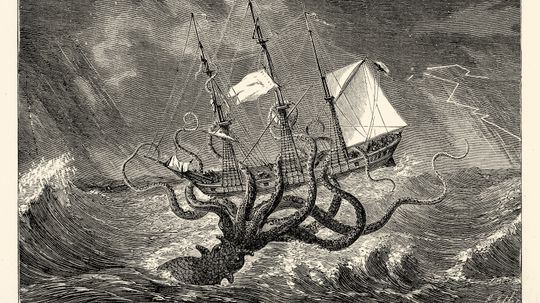Science Versus Myth
Are vampires real? What is an out-of-body experience? Are crop circles proof that aliens exist? HowStuffWorks explores what is real and what is urban legend with this collection of Science Versus Myth articles.

Top 10 Ghost Tours

Top 10 Hotels That Will Scare the Daylights Out of You

What's So Scary About The Winchester House Story?

The Pyramid in Antarctica Isn't Actually a Pyramid

The Spiritual Awakening Signaled by the 757 Angel Number

8888 Angel Number Meaning: Prosperity, Abundance, and Spiritual Growth

Spirit Guides Bring Believers Comfort, Insight, and Aid

Psychic Powers: Fun to Consider, Even Without Scientific Support

How to Manifest Love: Merging Mind and Heart

The Beast of Bray Road: Wisconsin's Claim to Cryptid Fame

Lougawou: A Haitian Vodou Werewolf

Orang Pendek: New Sumatran Primate or Just Another Cryptid?

Do Marfa Lights Come From UFOs, Cars, the Military or Ghosts?

Solfeggio Frequencies: Healing Tones or Pseudoscience?

Is Sacred Geometry Related to Science or Is It Simply Beautiful?

What If Cows Didn't Exist?

What If Earth's Magnetic Field Flipped?

What If Humans Could Breathe Underwater?
Learn More / Page 12
Confused about your love life? A love tarot spread can provide the clarity you need. Find the perfect layout to answer your burning questions and find your way to happiness.
By HowStuffWorks
he Hermit card: Solitude or isolation? Discover the real message this tarot card holds for your journey. Are you ready to go within.
By HowStuffWorks
Curious about your love life? Explore relationship spreads and uncover the hidden truths of your connections. Discover how tarot can guide your romantic journey.
By HowStuffWorks
Advertisement
Unlock insights with the concise Three-Card Spread. Learn its Tarot uses & interpretations. Discover past, present, future dynamics efficiently.
By HowStuffWorks
Is the Lovers card calling to you? Uncover its meaning in love, relationships, and the choices that shape your destiny.
By HowStuffWorks
What does the Chariot card REALLY mean for you? Find out how this powerful symbol can guide you towards success in love, career, and beyond. Get your personalized interpretation now.
By HowStuffWorks
The Strength card appears when you least expect it. Is it a sign of inner resilience or a call to embrace your wild side? Dive into the symbolism and unlock its hidden messages.
By HowStuffWorks
Advertisement
Does the Star card hold the key to your dreams? Discover its meaning in love, career, and life's journey. Find hope and inspiration here.
By HowStuffWorks
Discover the Wheel of Fortune card's symbolism and meanings. Explore its role in tarot readings. Unlock destiny and change with this powerful card.
By HowStuffWorks
The Justice card is more than just 'fairness.' Uncover the shocking hidden meaning this card reveals about your karma and life path
By HowStuffWorks
Unlock insights into The Hanged Man Card's meaning. Explore tarot's enigmatic symbolism and interpretations for personal growth.
By HowStuffWorks
Advertisement
The Death card: a symbol of destruction or liberation? Discover the surprisingly positive message hidden within this powerful Tarot card. Prepare to have your assumptions challenged.
By HowStuffWorks
Discover the harmony of The Temperance Card's meaning. Explore its balanced symbolism and interpretations for inner peace and growth.
By HowStuffWorks
The Devil card isn't what you think. Explore its seductive depths, understand its true symbolism, and unlock your hidden potential.
By HowStuffWorks
Unlock the deepest secrets of your intuition with The Moon Tarot card. This powerful card reveals hidden fears, subconscious desires, and the key to your inner wisdom. Are you ready to face your shadows?
By HowStuffWorks
Advertisement
What blessings await you? The Sun card illuminates your path to happiness and fulfillment. Uncover its secrets and embrace the light.
By HowStuffWorks
Want to unlock the secrets the Tarot holds for you? Discover powerful card spreads that reveal hidden truths about your love, career, and destiny. Dare to look?
By HowStuffWorks
The Yeti, often referred to as the "Abominable Snowman," is a legendary creature from Himalayan folklore.
Legends of the Kraken attacking ships date back to the Vikings. But since the giant squid ended up being real, could this aquatic cryptid be out there too?
Advertisement
The Magician: A master of manifestation... but are you using his powers wisely? Uncover the real meaning behind this potent card.
By HowStuffWorks
Learn to interpret the powerful High Priestess tarot card. Explore her meaning in the upright and reversed positions, and unlock a deeper understanding of yourself.
By HowStuffWorks
The Empress: Is she a blessing or a warning in your Tarot reading? Discover the secrets this powerful card reveals about your love life, career, and hidden potential...if you dare.
By HowStuffWorks
The Emperor tarot card embodies authority, structure, and...tyranny? Discover its complex meaning in love, career, and personal growth. Is he a force for good or a warning sign?
By HowStuffWorks
Advertisement
The Hierophant appears in your reading. What does it mean? Learn to interpret his message in both the upright and reversed positions.
By HowStuffWorks
The Fool upright is exciting, but reversed? Chaos! Learn how to avoid the pitfalls of this card and stay on the right path.
























